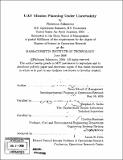UAV mission planning under uncertainty
Author(s)
Sakamoto, Philemon
DownloadFull printable version (10.10Mb)
Alternative title
Unmanned Aerial Vehicles mission planning under uncertainty
Other Contributors
Massachusetts Institute of Technology. Operations Research Center.
Advisor
Cynthia Barnhart.
Terms of use
Metadata
Show full item recordAbstract
With the continued development of high endurance Unmanned Aerial Vehicles (UAV) and Unmanned Combat Aerial Vehicles (UCAV) that are capable of performing autonomous fiunctions across the spectrum of military operations, one can envision a future military in which Air Component Commanders control forces comprised exclusively of unmanned vehicles. In order to properly manage and fully realize the capabilities of this UAV force, a control system must be in place that directs UAVs to targets and coordinates missions in a manner that provides an efficient allocation of resources. Additionally, a mission planner should account for the uncertainty inherent in the operations. Uncertainty, or stochasticity, manifests itself in most operations known to man. In the battlefield, such unknowns are especially real; the phenomenon is known as the fog of war. A good planner should develop plans that provide an efficient allocation of resources and take advantage of the system's true potential, while still providing ample "robustness" ill plans so that they are more likely executable and for a longer period of time. (cont.) In this research, we develop a UAV Mission Planner that couples the scheduling of tasks with the assignment of these tasks to UAVs, while maintaining the characteristics of longevity and efficiency in its plans. The planner is formulated as a Mixed Integer Program (MIP) that incorporates the Robust Optimization technique proposed by Bertsimas and Sim [12].
Description
Thesis (S.M.)--Massachusetts Institute of Technology, Sloan School of Management, Operations Research Center, 2006. Includes bibliographical references (p. 205-209).
Date issued
2006Department
Massachusetts Institute of Technology. Operations Research Center; Sloan School of ManagementPublisher
Massachusetts Institute of Technology
Keywords
Operations Research Center.